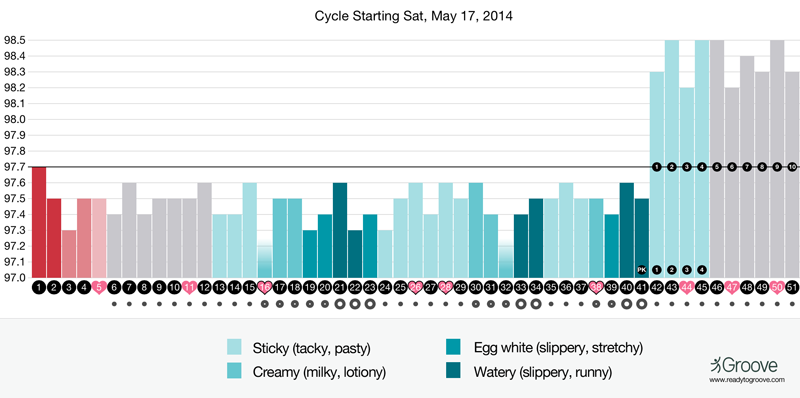LEARN
Period & Fertility Tracking
Improve or Maintain Reproductive Health with the Sympto-thermal Method of Fertility Awareness
This excerpt from The Cycle was written by Groove’s founder Jennifer Aldoretta
When you know what is normal and healthy for your cycle, it’s easy to detect when reproductive health might be on the decline. Things like stress, lack of sleep, too much exercise, illness, diet, and major life events can all delay ovulation and interfere with the menstrual cycle, so it comes as no surprise that taking a deeper look at a person’s cycle reveals a great deal about the state of that individual’s health.
Tracking your fertility signs using the sympto-thermal method of fertility awareness can assist in the diagnosis of many reproductive (and non-reproductive) health disorders such as polycystic ovarian syndrome (PCOS), luteal phase defect, and low thyroid function, to name a few. I would highly recommend getting in touch with a fertility awareness educator or menstrual health expert if you (or your partner) struggle, or possibly struggle, with any of these disorders.
Polycystic Ovary Syndrome (PCOS)
Polycystic ovary syndrome, commonly known as PCOS, is an endocrine disorder that often results in anovulation (or the absence of ovulation), and is a common cause of infertility. This anovulation generally results in long, highly irregular menstrual cycles. Individuals who suffer from PCOS may notice that they never see the rise in basal body temperature associated with ovulation.
This can lead to waves or long stretches of fertile cervical fluid that never result in ovulation. Oftentimes, the “menstruation” experienced by folks with PCOS is not menstruation in the true sense of the word. The “menstruation” they experience is merely withdrawal bleeding — similar to the bleeding experienced by hormonal contraceptive users.
A typical PCOS chart can be seen below. If you (or your partner) suffer from PCOS and are interested in using the sympto-thermal method of fertility awareness to avoid or achieve a pregnancy, I recommend that you get in touch with a fertility awareness educator.
People with PCOS typically experience very long cycles and erratic temperatures. This individual also experienced long phases of cervical fluid and several false peaks – or peak days that do not end in ovulation – which is common for those with PCOS. A noticeable basal body temperature spike indicating ovulation was also not present. Using the sympto-thermal method of fertility awareness for pregnancy prevention in this case is beyond the scope of the information we provide at Groove.
This individual had several false peak days, meaning that there were several times that cervical fluid (cervical mucus) progressed to slippery, fertile fluid (days 19-23 and days 33-34) but ovulation did not follow. Finally, on Cycle Day 42, this person experienced a temperature shift indicating successful ovulation. Since this person has irregular cycles, they must assume that the presence of slippery cervical fluid (cervical mucus) will be followed by ovulation.
Luteal Phase Defect
Luteal phase defect, or LPD, is marked by unusually low luteal phase progesterone levels or an unusually short luteal phase length (typically 10 days or less), and can result in difficulty conceiving. This difficulty with conception is possibly caused by an interference of the implantation of the embryo. Luteal Phase Defect can be medically treated, and there are ways you can lengthen your luteal phase naturally with diet and lifestyle changes…so don’t fret! Contact your physician or a fertility awareness educator or menstrual health expert if luteal phase defect is a potential concern for you.
Underactive Thyroid (or Hypothyroidism)
It’s not immediately obvious that an underactive thyroid (hypothyroidism) can manifest in the menstrual cycle. This may not be the case for everyone, but basal body temperature is often a good measure of thyroid function. Low thyroid function is defined by an insufficient production of thyroid hormones, leading to symptoms like weight gain, fatigue, constipation, irritability, menstrual irregularities, and low basal body temperature.
Although this fact is disputed, many believe that a pre-ovulatory basal body temperatures that are consistently lower than 97.0 °F (36.11 ºC) is a sign of sub-clinical hypothyroidism, which may not show up in standard lab tests. Contact your physician or fertility awareness educator or menstrual health expert if hypothyroidism is a concern for you.
Check out this sample chart showing underactive thyroid function.
Want to See More Sample Cycles?
Figuring out what’s going on with your body isn’t always easy. But once you know what to look out for, collecting data about your periods can give you a powerful look into the health of your hormones, your reproductive system, and your body.
We have lots of sample charts on our website to help you visualize things like:
your fertile phase
a pregnancy
miscarriage
polycystic ovary syndrome (PCOS)
anovulation
irregular cycles
hormonal imbalance
delayed ovulation
and more!


